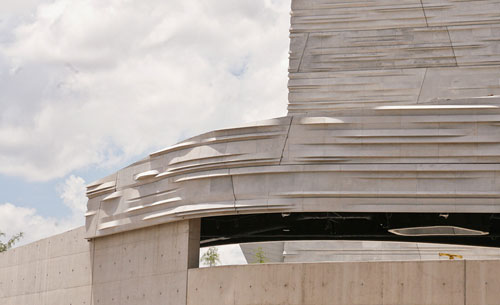Style and Sustainability of Precast Concrete
As part of realizing that goal, Mayne chose precast concrete as his primary building material, which has uniquely allowed him to achieve the style and long-term sustainability he envisioned for the facility.
The $185-million museum, which is expected to open in January 2013, will relocate collections from a facility in nearby Fair Park, a recreational and educational complex that since 2006 has been home to the collections of the Dallas Museum of Natural History, The Science Place, and the Dallas Children's Museum. “It's important for us to be thoughtful about the environmental aspects of the museum,” Nicole Small, the museum's CEO, recently told The Dallas Morning News. “We are a museum of nature and science. We have to practice what we preach.”
With specific environmental goals in mind, the facility was designed by Morphosis with the local architect Good, Fulton & Farrell to include a landscaped roof featuring native flora, a 50,000-gallon rainwater-collection system, and a solar water-heating system. Its construction would also incorporate recycled and locally sourced building materials. Condensation from the building's air-conditioning system will be collected as well, allowing the museum to keep its water bill closer to that of a residence than the typical costs for a 180,000-square-foot public facility.
 |
The design creates a series of waves for a dynamic effect on the building that changes through the day with the sunlight and shadows. Photo courtesy of Holcim (US) Inc. |
Still, in conceiving what the Perot Museum has described on its website as “a 'living' example of engineering, sustainability, and technology at work,” Mayne, who cofounded Morphosis in 1972, applies the firm's long-held philosophy that the meaning of an architectural work can be understood by absorbing the culture for which it was made. With this in mind, the architect eschewed what many would describe as a conventional approach to green design, at least from an aesthetic perspective.
Mayne does not believe that aesthetic uniqueness and building performance have to be mutually exclusive. As he proves with the Perot Museum, a building's design can reflect his vision and that of his client while being environmentally responsible. There are no rules, as Mayne has illuminated through his work, about what a so-called “green building” should look like, and it's not important that a building announce itself as the result of that intention. Mayne, in other words, prefers to show that a building can be visually compelling and environmentally responsible without necessarily having to tell people that's the case.
What Mayne and his colleagues came up with for the Perot Museum is a 14-story cube that appears to be suspended over the thoughtfully landscaped grounds that make up the balance of its 4.7-acre site. The building houses 11 permanent exhibition halls and a traveling exhibition space, educational facilities, a theater, museum store, café, and sprawling podium rooftop. The podium roof is designed with landscaping by Dallas-based Talley Associates that blurs the distinction between where the natural environment ends and the building itself begins.
| Evaluating Precast Concrete |
Precast concrete panels have a long average service life due to their durable, low-maintenance surfaces, according to the Chicago-based Precast/Prestressed Concrete Institute (PCI). That’s just one reason—and an important one—that precast was selected for a monumental green building like the Perot Museum of Nature and Science in Dallas. The other reasons to consider precast, says PCI, include:
|
Seemingly Kinetic Exterior
The line between structure and space is audaciously delineated by a 150-foot, glass-enclosed shaft, in which a 54-foot escalator travels at an angle along the building's exterior, opening the museum to its surroundings and inviting those beyond the facility's walls inside. It is a connective feature of which Mayne is particularly proud.
The aesthetically punctuating escalator shaft draws attention to the building's seemingly kinetic concrete exterior. The design intent, according to museum officials, was to “create a series of waves that gives a dynamic effect on the building that changes minute-to-minute through the day with the sunlight and shadows.” The texturing is denser at the bottom of the cube and slowly fades away as the cladding move upwards. According to the museum, “This pattern was done intentionally to create a perception that the building dissolves into the sky.”
 |
The line between structure and space is audaciously delineated by a 150-foot, glass-enclosed shaft, in which a 54-foot escalator travels at an angle along the building’s exterior—a signature feature by the architect Thom Mayne. Photo courtesy of Holcim (US) Inc. |
The museum's exterior is made up of more than 650 precast concrete panels that were fabricated in Hillsboro, Texas, by the Gate Precast Company, a large precast provider with headquarters in Jacksonville, Florida. The panels make up a number of elements, including the vertical portions of the site's large plinth, the 14-story cubelike tower, and the exterior of the building's memorable atrium.
The construction of the building enclosure was no simple feat; it was the result of what Christopher Wolfe, of the project's general contractor, Balfour Beatty Construction, told Engineering News-Record was “the most difficult and challenging precast job I've ever seen.” The design of the concrete panels—which average about 8 feet by 30 feet in size with thicknesses of up to 9-½ inches—resulted in weights of as much as 8 tons each. The panel profiles are intricate and carefully organized to achieve Mayne's design effect; this demanded close coordination among the architect, engineers, the general contractor, the concrete supplier, and Gate Precast's craftsmen, who brought that aspect of the project to fruition.









